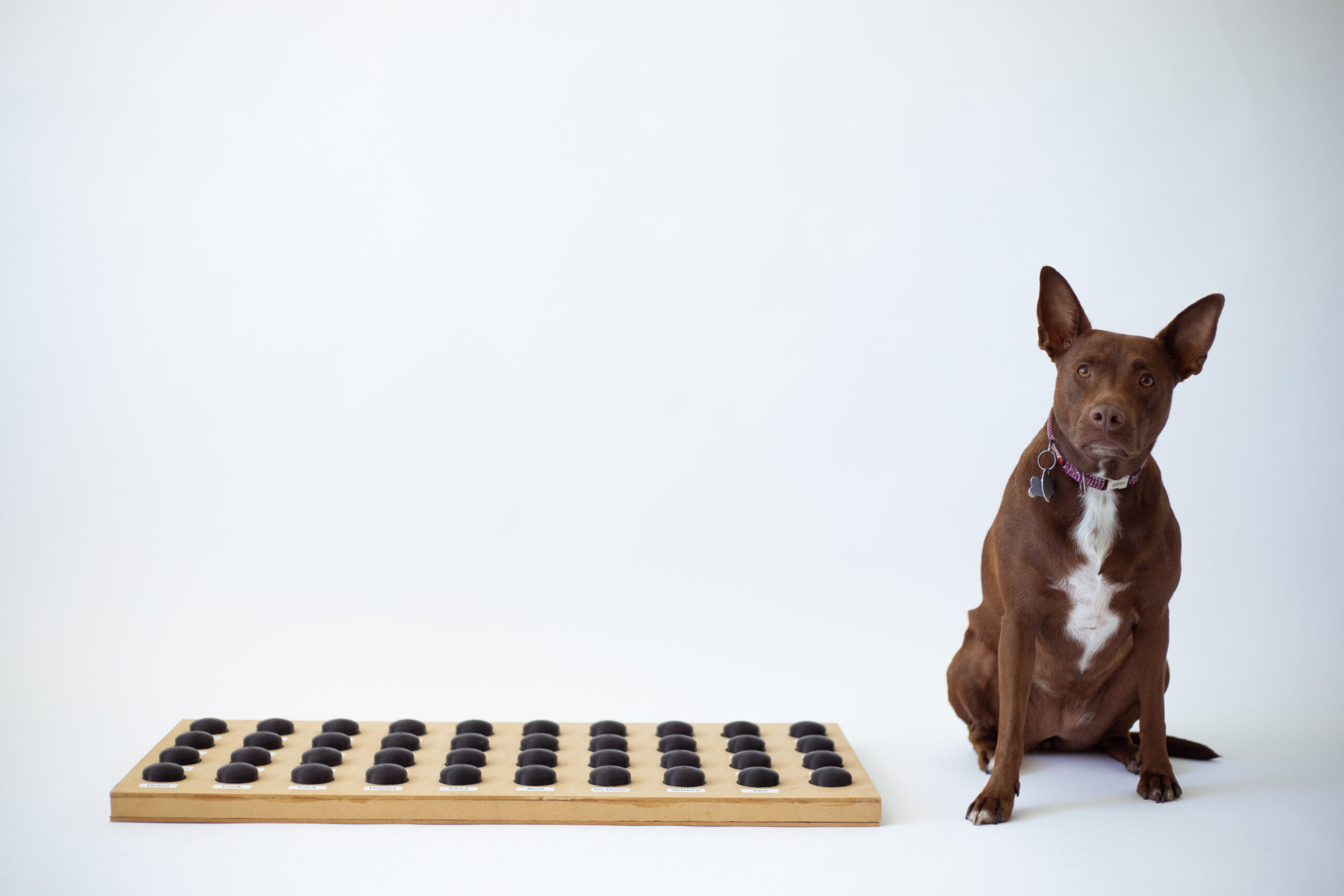Humans have been fascinated with the idea of talking dogs for ages. Fantasizing about what our furry companions would say if we shared the same language has inspired countless cartoons, movies, books, and more. But now, what was once only dreamed about is becoming reality. It’s just in a different way than society ever envisioned. Dogs are talking. They’re not forming words with their mouths, they’re using communication devices consisting of buttons that say different words to express their thoughts, wants, and needs.
So, what’s really happening with these dogs and their buttons? Are they really talking?
In order to understand how dogs are talking with buttons, we need to understand what different types of language mean. There are two main components to language: receptive language (understanding / comprehension) and expressive language (output). Verbal speech is just one type of expressive language. Other types include but are not limited to sign language, typing on a keyboard, writing, or using a communication device to talk.
Research shows that dogs are capable of understanding the words they’re hearing in their environments. According to the American Psychological Association, the average dog understands more than 150 words and has cognitive capabilities similar to a 2-2.5 year old human child. And when we intentionally teach words to dogs, they’re capable of understanding significantly more than ever expected. You can read more about dog’s language abilities in my book.
The late Dr. John Pilley published a research paper in 2010 showing how he taught his border collie, Chaser, to learn the names of over 1000 different toys. He also studied Chaser’s understanding of word combinations and different syntax patterns. Chaser didn’t just understand what single words meant, she also understood what they meant combined together.
Researchers have concluded that “dogs process both what we say and how we say it in a way which is amazingly similar to how human brains do.”
Now that dogs’ receptive language skills have been studied and documented, expressive language was the next natural step in the quest for more answers about our pets’ potential. Since verbal speech is only one way to say words, we had to find another way for dogs to access the words they were hearing and understanding every day. That’s where buttons came into play.
By recording words that dogs hear us use all the time into paw-sized buttons that they can push, for the first time in history, dogs have a way to say words back to us. Human language can be reciprocal.
Now, there is a BIG difference between a dog being trained to push buttons that say words, and a dog using buttons that say words as a symbolic form of communication. When taught correctly, dogs are demonstrating the following skills which are consistent with definitions of language use:
Using words spontaneously (un-prompted)
While dogs (and children) may need cues as they’re just learning new words, saying words completely independently is the hallmark of language use vs. a trained trick. The former is equivalent to a toddler saying “ball” on her own to express that she wants to play with the ball. The latter equates to the toddler only saying “ball” when asked “What is this?” instead of using it functionally for communicative purposes. Dogs are using all different kinds of words (nouns, verbs, prepositions, adjectives, etc.) spontaneously in appropriate contexts.
Generalizing words
Using words in different environments, with more than one person, and for multiple meanings indicates language use. For example, dogs are saying “play” to talk about a variety of different types of play, playing with different people, different toys, and in different locations rather than “play” meaning one specific type of activity.
Combining words together to create unique phrases and sentences
Some of the most mind-blowing evidence of dogs talking has been observing how they combine words together to create phrases. Instead of just pushing one button to say “outside” for example, dogs are able to combine individual words together to make phrases such as “Want come outside,” “Play outside park,” etc. Dogs are creating phrases that have never been modeled before, and are using them consistently for the same meanings.
Using words for a variety of communication functions
Communication is more than requesting! Dogs are using words not only to request objects, actions, or people, but also to comment on their environment, protest, label, ask questions, answer questions, express a feeling, direct the action of others, and much more.
Using circumlocutions
Circumlocution means talking around a word. With having a finite amount of buttons, sometimes dogs want to express something they don’t have a specific word for. When this happens, dogs are using their available vocabulary to create a new phrase to represent the desired concept. For example, when Stella’s “beach” button broke, she said the phrase “help water outside” to communicate about this experience. When Stella didn’t have a word for “towel”, she used “outside blanket” to ask for a towel when she was still wet.
Yes, dogs are talking, and we’re learning more about our pets than ever before. Learn more about how I discovered that dogs were capable of talking here, in my book, How Stella Learned to Talk: The Groundbreaking Story of the World’s First Talking Dog.
You can join the millions around the world giving their own pets a voice by getting started with Hunger for Words’ pet communication essentials.


